
Portable Surgical Kits Page Menu: 1 2 3 4 5 6 7 8 9 Next>>
Portable Surgical Kits From the Golden Age of Piracy, Page 8
Portable Instrument Kits: Barbering Tools
Sea surgeon John Woodall is the only sea surgeon writing around this period to mention that sea surgeons should have a
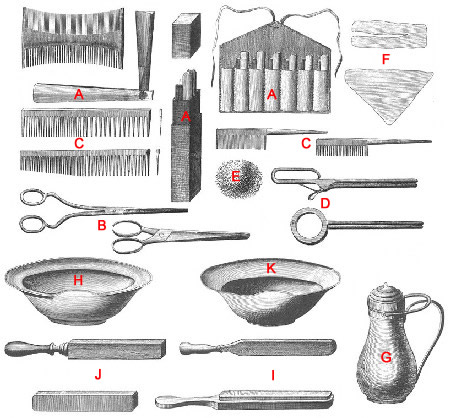
Mid-18th Century Barbering Tools from Encyclopedie des
Sciences et Metiers
Vol. 7,
p. 115-6,
by Denis Diderot (1769) Item Explanations are below.
Note: This image has been modified from the original to match John Woodall's list.
barbers kit, although barbering was considered a necessary and important part of a ship's surgeon's office. This would not usually be performed by the surgeon himself when he had assistants or mates to whom he could assign the duty. With regard to the barber's tools, Woodall advises that "the Surgions Mate by due consequent is to be Barber to the Ships Company, he ought not to be wanting of these following necessaries."1
Woodall then goes on to list the instruments he feels are necessary in the barber's kit. Note that I have added letters shown in red to correspond with the image seen at left which is taken from the 1769 Encyclopedie des Sciences et Metiers Vol. 7. Note that this image was drawn 150 years after Woodall wrote his book and while the instrument design and purposes are similar, their style may be different.
In addition to the red letters, blue letters have also been added to those instruments not included in the image to use for future use in explaining the differences between Woodall's list and other lists in this article. Let's look at Woodall's list of barber's tools.
One Barbours case, containing,
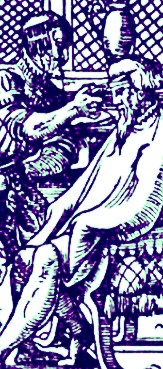
Barber Cutting Hair,
From Das Standebuch,
By Jost Amman (1586)
|
Rasours foure. (A) Scissers two paire. (B) Combes three. (C) Combes-brush one. (M) Eare-picker one.(O) Curling Instruments. (D) Turning Instruments and Spunges. (E) Mallet [Mullet - small forceps] one. (P) Gravers two. (Q) phlegme [Fleam] one. (R) Paring knives two. (S) Looking glasse one. (T) |
Aprons three.(L) |
Notice that several of the instruments which Woodall includes are also found in some of the surgeon's plaster boxes and pocket kits discussed previously. These include the razors, scissors, ear-picker, gravers, fleam and hone. The razors and scissors found in a barber's box were more purpose-specific than those found in the portable surgical kits. Woodall says that the surgeon must "have at least two paire of good sizers for to cut haire, that they be well ground, an kept cleane"3, suggesting these were different from his surgical scissors. The other instruments found here and in surgeon's portable kits would have likely been the same since they were used for the same purpose. The ear-picker and whet stone seem to be more logically included with the barbers kit, although they may have been of some use to the surgeon who didn't have his barbering kit handy in the field.
Although not a surgeon, Randle Holme included two lists of instruments appropriate for a barber's kit. Holme was writing a book about emblems found on heraldry devices that basically became a type of encyclopedia. Although it is impossible to say for sure, it seems likely that this list may have been based upon a kit or selection of kits he found among land-based barbers. It is clearly more focused on barbering and less on surgery than Woodall's list. Red and blue letters indicate which items correspond to those found in Woodall's list of barbering instruments.
Instruments of a Barber.
The Instrument Case, in which are placed these following things in their several divisions.
| The Glass or seeing Glass. (T) A Set of New Combs, with Teeth on one side, and wide. (C) A Set of Box Combs. (C) A Set of Ivory Combs, with fine Teeth, and toothed on both sides. An Ivory Beard Comb. (C?) A four square Bottle with a Screw’d head for sweet Water or Benjamin Water, &c. (N) The like Bottle with sweet Powder in; but this is now not used. A Row of Razors. (A) A pair of Tweesers, or Twitchers: with an Ear pick at the other end of it. (O) A Rasp or File, to file a point of a tooth that stands out. A set of Cisers, for the cutting of the Hair and Beard. (C) A Curling Iron, or Beard Iron, called the Forceps. (D) A hone to set or sharpen the Razers. (I) |
A Bottle of Oyle, sweet Oyle, or Oyle Olive for the Hone. |
Photo: Peter van der Sluijs - Lice_Comb, Netherlands (17th c.)
Perhaps the biggest difference between the tools Holme includes in this list and those Woodall includes is the number of combs. Woodall simply notes that the surgeon should have three combs. Holme suggests a number of sets of combs be included here. He includes a set of 'new' combs with teeth on one side only, another set of box combs which probably refer to square combs that had teeth on both sides (see image at left) which were used to comb for lice. He mentions a third set of comb made of ivory which had 'fine teeth', also being found on both sides of the comb. These could also be used to remove lice as well as to 'clean' hair because of the fine spacing of the teeth. Last, Holme mentions an ivory beard comb. Woodall does not give enough detail to suggest that a beard comb would be found among his recommended three, but it was possible. It is generally found that men during the late 17th and early 18th century did not wear facial hair, however, so it may not have been necessary for a ship's surgeon to have a beard comb. It also seem doubtful that most sea surgeons would want an ivory comb given their greater expense and potential for theft, although without further information this cannot be said with any certainty.
Holme includes a dental tool that Woodall does not mention - a rasp (or file) for filing down a snaggletooth. This was one of the many instruments that was included by William Fabry in his surgeon's pocket kit. Many of the items Holme includes which Woodall does not are niceties that might have been lost on sailors such as washing balls, hair powder and puffs to apply powder. He also has two chaffing dishes to heat liquids in, something that would not usually be done on a ship due to the danger of fire
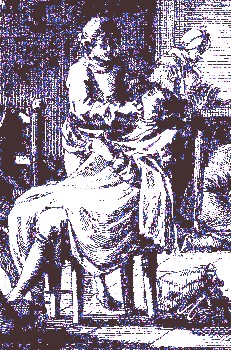
Encyclopedie, Vol. 7, p. 115, Denis Diderot (1769)
in the world of wood, canvas, rope and tar. Of course, Woodall may have included such things in his last, catch-all list item: "what else is necessary to the Barbers profession"5.
Holme then provides a second list of items to be placed in the barber's box along with a second drawing of the box. The above list is part of Holme's description of barbering while the second list is included with his description of surgical instruments. Some quick background on the relationship between barbers and surgeons is necessary to understand why this is important.
There was a sort of uneasy alliance between the barbers and surgeons during this period in history. Until 1745, they were part of the same company, the Company of Barbers and Surgeons. However a divide existed between the two groups with some men choosing to be nothing but barbers, others to be nothing but surgeons and still others swerving a bit loosely between the two career paths. (For more on this, see the article this page of the article on barbering.)
As a result, it should not be entirely surprising that the two different barber's portable kits contain instruments appropriate for different aspects of the trade. Since the second list is found among the surgical instruments, Holme includes fewer barber tools and more surgical tools. He prefaces this list noting that it contains "all the Instruments for Barbering, Shaving, or Polling or Cutting of Hair"6.
Razors 3 or 4 (A) |
Sweet water in Bottles. (N) |
Perhaps the most interesting aspect of this list is how well it agrees with Woodall's list in instruments listed, order of the listing and quantities of tools included. Unlike Holme's first list, it is shown in two columns, the same way Woodall presented his list of barbering instruments. (Note: the first of Holme's lists was shown in this article in two columns to conserve space. It appears as a single column list in Holme's book.) It is even possible that this list is taken in part from Woodall's book. Woodall's the surgions mate was very likely still popular among sea surgeons in the mid 1680s, having been last published about 30 years before in 1655. In fact, the only items Holme includes that Woodall doesn't are a powder and a puff, a toothpick, scrapers and tweezers. However, several things Woodall does include are not included by Holme including aprons, various bowels, blade sharpening tools and sweet water.
1 John Woodall, the surgions mate, 1639 Edition, not paginated; 2 Woodall, ibid; 3 John Woodall, the surgions mate, 1617, p. 25; 4 Randle Holme, The academy of armory, Book III, 1688, p. 127-8; 5 Woodall, not paginated; 6,7 Holme, p. 438
Portable Instrument Kits: Barber's Case
There is very little information on the type of portable barber's case that a barber would carry, let alone a ship's surgeon's mate who had to perform barbering as a part of his duties. Both encyclopedist Randle Holme and sea surgeon John Woodall mention that the tools were contained in a barber's case or instrument case.1 Woodall doesn't give any specifics on the case. Holme
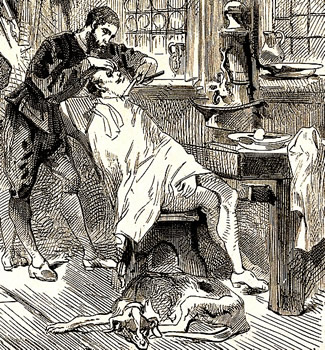
Artist: J. Ansseau
An apprentice barber-surgeon, From the Wellcome Collection
gives a minimal description of the case, explaining that it is "a Barbers Case of Instruments closed Gules [red], Garnished [decorated] and Lock and handle, Or. By the name of Trim."2 Whether this description refers to an actual barber's box or to the way it was to be displayed on heraldic devices is not entirely clear. ('Gules' refers specifically to 'heraldry red'.3 Keep in mind that Holme was writing about such things rather than creating a strict encyclopedia.)
Fortunately, Holme also provides images. In fact, he supplies both an image of the case with the lid closed and another with it open. Unfortunately, as will be seen below, these images do not provide a tremendous amount of information due to their simplicity. However, much can be gleaned from them.
There is definitely a design on Holme's barber's case, something he points out. That, combined with its shape, suggest that it may have been a wooden box covered in tooled leather, possibly dyed red. The lock and handle are both very evident in these images. Based upon the size of the handle and the intuited size of the instruments the box contained, it would probably have been about 8-10 inches tall. 4 to 7 inches deep and about 4-7 inches wide. (This is sheerest guesswork based on a really basic drawing, so caveat emptor.)
Another take on a barber's 'case' can be found in Denis Diderot's 1769 Encyclopedie. There is nothing at all as formal about this container, which appears to be little more than a cloth or leather bag, with a pair of scissors hanging out of it, which is sitting on the floor behind the chair where the patron is sitting. It must also be noted that this image appeared about 40 years after the time period of interest.
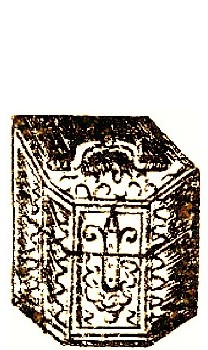 Barber's Box Closed, The academy of arrmory, Bk III, Randle Holme (1688) |
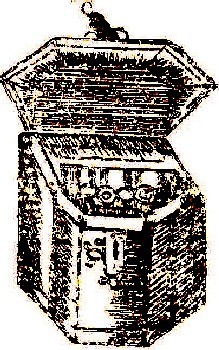 Barber's Box Open, The academy of arrmory, Bk III, Randle Holme (1688) |
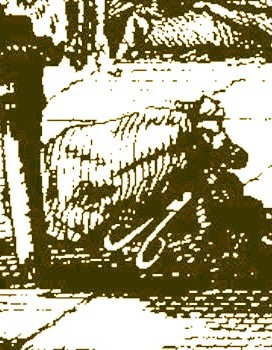 Barber's Bag and Tools, From Encyclopedie, By Denis Diderot, Vol. 7, p. 115 (1769) |
1 See John Woodall, the surgions mate, 1639 Edition, not paginated & Randle Holme, The academy of armory, Book III, 1688, p.127 & 438; 2 Holme, p. 437; 3 "Gules", thefreedictionary.com, gathered 1/11/17

